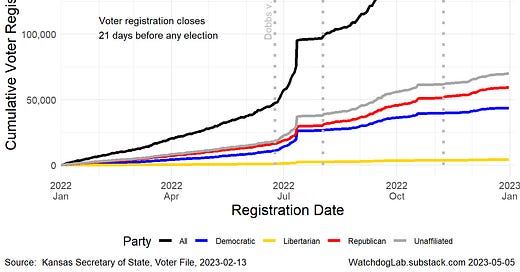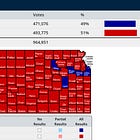How did the US Supreme Court's Dobbs decision affect Kansas Voter Registration in 2022?
The Dobbs decision was released only weeks before the "Value Them Both" Kansas constitutional amendment vote
How did the issue of abortion affect new voter registration in Kansas last year?
The US Supreme Court announced its decision in the Dobbs case on June 24, 2022 slightly more than two months before Kansas voters would decide the “Value Them Both” constitutional amendment.
The Court held the US Constitution does not confer a right to abortion and returned the power to regulate abortion to the states.
A Kansas constitutional amendment, “Value Them Both,” was on the Aug. 3, 2022 ballot to enable the Kansas legislature to permit basic regulations on abortion, which a Kansas Supreme Court ruling had blocked.
How did the Dobbs decision affect voter registration in Kansas before the vote on the constitutional amendment?
2022 Voter Registration by Party
The Dobbs decision to overturn Roe v Wade triggered sharp increases in voter registrations in June 2022 prior to the Aug. primary.
Statewide increases were high for Republicans but higher for unaffiliated voters.

The large increase in voter registrations before the August primary shifted some the registrations to earlier in the year that would have occurred before the Nov. general election.
2022 Voter Registration by Gender
New female voters outpaced new male votes in anticipation of the VTB vote in Aug 2022.
In March 2023 voter registration data from the Kanas Secretary of State there were over 93,000 more female voters than males voters in Kansas. (1,015,786 females vs 922,404 males).
Comparison to Recent Years
In 2021 and 2022, unaffiliated voters in Kansas outpaced new voter registrations by either Republicans or Democrats. However, in 2020 Republican enjoyed a narrow edge in total registrations.
From 2020 through 2022 female registrations outpaced male registrations.
2021
Cumulative voter registrations by party are mostly straight lines in odd-numbered years. The order of the party lines varies by counties within the state, however.











I'm not sure how I can draw any conclusion about that from the data, since both sides may have been motivated to increase registrations before the election. I plan to publish some turnout curves for that election soon, which may give some insights by party and gender, but not about the timing of those rushing to register.
Earl, given the results of the VTB vote in Kansas this past summer and your analysis here, would it be fair to say that Republican women who registered to vote shortly after the Dobbs decision were likely largely responsible for the lopsided no vote totals?